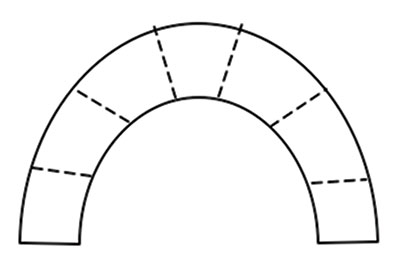Clarinetists who have a rigorous practice schedule sometimes complain of a sore or sensitive lower lip. As a result, they may have to reduce their practice time or stop practicing altogether so the lip can heal. If performers choose to practice with a sore lip because of an impending performance, they are likely to see impeded progress and become frustrated.

Soreness of the Inside Lower Lip
If the lower lip is sore on the inside, smooth portion just above the lower teeth, the cause is pressure from the lower teeth. Even if this pressure is minimal, soreness may still occur as the teeth leave small indentions on the underside of the lower lip. If a chronic sore lip is severe and allowed to continue over a long period of time, permanent damage to the nerves of the lower lip may result.
Factors that directly influence the amount of pressure exerted on the lower lip are breath support, embouchure formation, mouthpiece and reed selection, sharpness of lower teeth, and braces. If a clarinetist is experiencing soreness and pain in this area of the lower lip, each of the above factors should be examined first to determine if the cause of lower lip pain can be eliminated through adjustment in one or more of these areas.
Breath support is an important aspect of embouchure pressure. If performers do not provide enough breath support when playing, an excessive amount of jaw pressure might be used to compensate for the difference, resulting in teeth marks on the lower lip. When playing, clarinetists should push a consistent, fast moving, concentrated flow of air into the mouthpiece. If this is done, any excessive pressure applied to the lower lip from the teeth can be eliminated.
Incorrect embouchure formation can also cause a sore lower lip. This is most likely to occur when there is inadequate support from the facial muscles located underneath the bottom lip, causing the collapse and bunching up of chin muscles under the lower lip. When the chin muscles are allowed to bunch up, too much lower lip comes into contact with the reed, creating tone and response problems. In addition, the support needed to suspend the lower lip over the bottom teeth is absent, which can result in teeth marks on the underside of the lip. Students who try to perform with an incorrect embouchure may experience poor tone, intonation problems, poor instrument response, and many times a chronic, sore, lower lip.
Another cause of a sore lip could be incorrect mouthpiece and reed selection. If a mouthpiece and reed combination requires more embouchure strength than a clarinetist can give, the result will be excessive jaw pressure and teeth marks on the lower lip. To solve this problem, clarinetists should select a mouthpiece and reed that can be easily controlled and gradually move into larger mouthpiece tip openings or harder reeds.
The sharpness of the bottom teeth also has a direct effect on lower lip soreness and pain. For some clarinetists, even when using good breath support, correct embouchure formation, and the appropriate mouthpiece and reed, teeth marks can still occur on the lower lip, especially if the lower teeth are sharp. This is most common for clarinetists who have an overbite in which the top teeth and lower teeth never touch at their tips. In such cases, the lower teeth can remain quite sharp because chewing never dulls the tips. To solve this problem, some clarinetists elect to have their lower teeth filed by a dentist to make playing more comfortable. However, the dentist can only file so much off of the teeth to dull them, and many times this is not enough to alleviate the problem.
Another major factor that can cause lower lip soreness and pain is braces. Many people must wear braces during their formative years of development, usually beginning in middle school. This is also the same time that many musicians begin playing the clarinet. In addition to lower lip pain caused by contact with the lower teeth, braces can be a major source of frustration if they irritate the lower lip. Some dentists recommend using wax on the braces to alleviate this problem but this is often ineffective. If this is the case, clarinetists must cope with this situation until the braces are removed.
A Cover for the Lower Teeth
Some clarinetists develop a chronic sore lip even though they are doing everything correctly. Many of these clarinetists learn to deal with this problem until the skin toughens or by slightly adjusting the placement of the lower lip so the teeth contact a different spot of the lip each time they perform. For others, a different solution is needed. An excellent choice for those performers is to use a cover for the lower teeth.
Cover refers to a dental device that provides a cushion between the teeth and lower lip as the clarinet embouchure is formed. It creates a smooth contact point for the lower lip and teeth and eliminates teeth abrasions sometimes made on the lip even when the embouchure is formed correctly. By providing a more comfortable contact point for the lower lip and teeth, the cover increases practice productivity, lengthens practice time, and allows students to practice and perform without pain in the lower lip. Covers can be made by individual performers or a dentist or purchased from a music store. They are constructed out of a variety of materials depending on the clarinetist’s preferences and can be temporary or more permanent.
Some performers simply fold a piece of paper or plastic over the lower teeth to reduce lower lip pain. However, this method is not recommended because paper or plastic is an unstable material and will last for only a short period of time. Another problem with this method is that the shape of the paper or plastic will likely be inconsistent from one practice session to the next; it may not be folded exactly the same way each time or may not actually take the shape of the teeth as it is placed over the teeth. Therefore, the clarinetist is playing with a slightly different embouchure each practice session due to a lack of consistency.
Making a Wax/Fiber Cover
A better choice for making covers is a wax and fiber material found in denture pads. Denture pads are originally designed to provide a snug fit between the gum and dentures. The wax and fiber material found in denture pads is flexible, will mold to the teeth, and is stable enough to make excellent covers. EZO is a common brand of denture pad and can be purchased inexpensively at many department or drug stores. They usually are sold with fifteen pads in a box and are made in different shapes (for upper or lower dentures) and thickness (light, medium or heavy gauges). Lower, heavy gauge is recommended.
To make a cover from an EZO denture pad, take one denture pad and cut it into the approximate size and shape to cover the bottom four front teeth. Usually a small rectangle shape with rounded corners works best. One denture pad will make between five and seven covers depending upon size.

Fold the cover over the bottom teeth and gently press down and inward towards the teeth, allowing the cover to conform. As the cover becomes warm from being placed in the mouth, it will become more flexible and take on the shape and size of the teeth. Make sure that the cover does not extend so far down on the teeth that it may touch and irritate the gums.
Once the cover is molded to the lower teeth, the clarinetist should play the instrument while adjusting the cover as it settles in. The cover may move slightly and may need to be centered again over the lower teeth. As playing continues, the tips of the lower teeth will make indentions into the wax, which will keep the cover from moving.
The cover, when removed from the mouth, will harden into the shape of the lower teeth. This will allow the clarinetist at the next practice session to simply slip the cover over the teeth for a perfect fit. Although the cover will become flexible again when placed back into the mouth, if it is placed over the teeth, it will not lose its shape. The cover will soon feel like a natural part of the embouchure.
Covers made from denture pads will last for several weeks to several months, depending on the amount of practice and how much lower jaw pressure is applied by the clarinetist. Eventually the lower teeth will wear through the cover and another one will have to be made. However, one box of denture pads could last several years. Clarinetists who use a cover will be able to practice for longer periods of time without pain and injury to the lower lip, increasing their productivity and allowing them to enjoy performing once again.






